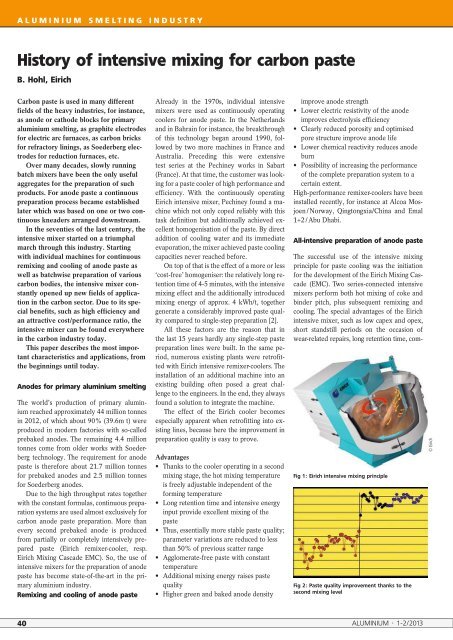special - ALUMINIUM-Nachrichten – ALU-WEB.DE
special - ALUMINIUM-Nachrichten – ALU-WEB.DE
special - ALUMINIUM-Nachrichten – ALU-WEB.DE
You also want an ePaper? Increase the reach of your titles
YUMPU automatically turns print PDFs into web optimized ePapers that Google loves.
<strong><strong>ALU</strong>MINIUM</strong> SMELTING INDUSTRY<br />
History of intensive mixing for carbon paste<br />
B. Hohl, Eirich<br />
Carbon paste is used in many different<br />
fields of the heavy industries, for instance,<br />
as anode or cathode blocks for primary<br />
aluminium smelting, as graphite electrodes<br />
for electric arc furnaces, as carbon bricks<br />
for refractory linings, as Soederberg electrodes<br />
for reduction furnaces, etc.<br />
Over many decades, slowly running<br />
batch mixers have been the only useful<br />
aggregates for the preparation of such<br />
products. For anode paste a continuous<br />
preparation process became established<br />
later which was based on one or two continuous<br />
kneaders arranged downstream.<br />
In the seventies of the last century, the<br />
intensive mixer started on a triumphal<br />
march through this industry. Starting<br />
with individual machines for continuous<br />
remixing and cooling of anode paste as<br />
well as batchwise preparation of various<br />
carbon bodies, the intensive mixer constantly<br />
opened up new fields of application<br />
in the carbon sector. Due to its <strong>special</strong><br />
benefits, such as high efficiency and<br />
an attractive cost/performance ratio, the<br />
intensive mixer can be found everywhere<br />
in the carbon industry today.<br />
This paper describes the most important<br />
characteristics and applications, from<br />
the beginnings until today.<br />
Anodes for primary aluminium smelting<br />
The world’s production of primary aluminium<br />
reached approximately 44 million tonnes<br />
in 2012, of which about 90% (39.6m t) were<br />
produced in modern factories with so-called<br />
prebaked anodes. The remaining 4.4 million<br />
tonnes come from older works with Soederberg<br />
technology. The requirement for anode<br />
paste is therefore about 21.7 million tonnes<br />
for prebaked anodes and 2.5 million tonnes<br />
for Soederberg anodes.<br />
Due to the high throughput rates together<br />
with the constant formulas, continuous preparation<br />
systems are used almost exclusively for<br />
carbon anode paste preparation. More than<br />
every second prebaked anode is produced<br />
from partially or completely intensively prepared<br />
paste (Eirich remixer-cooler, resp.<br />
Eirich Mixing Cascade EMC). So, the use of<br />
intensive mixers for the preparation of anode<br />
paste has become state-of-the-art in the primary<br />
aluminium industry.<br />
Remixing and cooling of anode paste<br />
Already in the 1970s, individual intensive<br />
mixers were used as continuously operating<br />
coolers for anode paste. In the Netherlands<br />
and in Bahrain for instance, the breakthrough<br />
of this technology began around 1990, followed<br />
by two more machines in France and<br />
Australia. Preceding this were extensive<br />
test series at the Pechiney works in Sabart<br />
(France). At that time, the customer was looking<br />
for a paste cooler of high performance and<br />
efficiency. With the continuously operating<br />
Eirich intensive mixer, Pechiney found a machine<br />
which not only coped reliably with this<br />
task definition but additionally achieved excellent<br />
homogenisation of the paste. By direct<br />
addition of cooling water and its immediate<br />
evaporation, the mixer achieved paste cooling<br />
capacities never reached before.<br />
On top of that is the effect of a more or less<br />
‘cost-free’ homogeniser: the relatively long retention<br />
time of 4-5 minutes, with the intensive<br />
mixing effect and the additionally introduced<br />
mixing energy of approx. 4 kWh/t, together<br />
generate a considerably improved paste quality<br />
compared to single-step preparation [2].<br />
All these factors are the reason that in<br />
the last 15 years hardly any single-step paste<br />
preparation lines were built. In the same period,<br />
numerous existing plants were retrofitted<br />
with Eirich intensive remixer-coolers. The<br />
installation of an additional machine into an<br />
existing building often posed a great challenge<br />
to the engineers. In the end, they always<br />
found a solution to integrate the machine.<br />
The effect of the Eirich cooler becomes<br />
e<strong>special</strong>ly apparent when retrofitting into existing<br />
lines, because here the improvement in<br />
preparation quality is easy to prove.<br />
Advantages<br />
• Thanks to the cooler operating in a second<br />
mixing stage, the hot mixing temperature<br />
is freely adjustable independent of the<br />
forming temperature<br />
• Long retention time and intensive energy<br />
input provide excellent mixing of the<br />
paste<br />
• Thus, essentially more stable paste quality;<br />
parameter variations are reduced to less<br />
than 50% of previous scatter range<br />
• Agglomerate-free paste with constant<br />
temperature<br />
• Additional mixing energy raises paste<br />
quality<br />
• Higher green and baked anode density<br />
improve anode strength<br />
• Lower electric resistivity of the anode<br />
improves electrolysis efficiency<br />
• Clearly reduced porosity and optimised<br />
pore structure improve anode life<br />
• Lower chemical reactivity reduces anode<br />
burn<br />
• Possibility of increasing the performance<br />
of the complete preparation system to a<br />
certain extent.<br />
High-performance remixer-coolers have been<br />
installed recently, for instance at Alcoa Mosjoen<br />
/ Norway, Qingtongxia/China and Emal<br />
1+2 / Abu Dhabi.<br />
All-intensive preparation of anode paste<br />
The successful use of the intensive mixing<br />
principle for paste cooling was the initiation<br />
for the development of the Eirich Mixing Cascade<br />
(EMC). Two series-connected intensive<br />
mixers perform both hot mixing of coke and<br />
binder pitch, plus subsequent remixing and<br />
cooling. The <strong>special</strong> advantages of the Eirich<br />
intensive mixer, such as low capex and opex,<br />
short standstill periods on the occasion of<br />
wear-related repairs, long retention time, com-<br />
Fig 1: Eirich intensive mixing principle<br />
Fig 2: Paste quality improvement thanks to the<br />
second mixing level<br />
© Eirich<br />
40 <strong><strong>ALU</strong>MINIUM</strong> · 1-2/2013
















